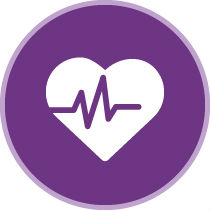Heart Attack

Serious Illness Definition
Heart attack is one of the illnesses covered by our Serious Illness Benefit. We define it as one that is diagnosed by a consultant cardiologist, which has resulted in the permanent reduction of the heart's efficiency as a pump. The reduction in efficiency is measured by ejection fraction at least one month after the heart attack. The ejection fraction must be 45% or less.
When the policy would and wouldn’t pay out
Some heart attacks are more severe than others and will have a longer lasting impact on an individual’s health and wellbeing. The ejection fraction is an important measurement in determining how well your heart is pumping. It can be used to determine the impact after a heart attack. Damage to the muscle of the heart sustained during a heart attack impairs the heart’s ability to pump blood and therefore reduces the ejection fraction.
Normal ejection fraction levels are at 50% and above. This policy will pay out if as a result of the heart attack the ejection fraction has reduced to 45% or less.
See below further information about the ejection fractions and which levels are covered by this policy.
| Ejection Fraction | Physical impact | Covered? |
|---|---|---|
| Greater than 45% | Normal ejection fraction levels are at 50% and above. The physical impact of a reduced ejection fraction will vary for each person but at levels above 45% ordinary physical activity will not tend to cause fatigue, breathlessness or palpitation. | No |
| Less than or equal to 45% | As the ejection fraction reduces further, symptoms may become noticeable during activity to the point at which they are evident even at rest. This typically occurs when the ejection fraction has reduced below 40%. | Yes |

